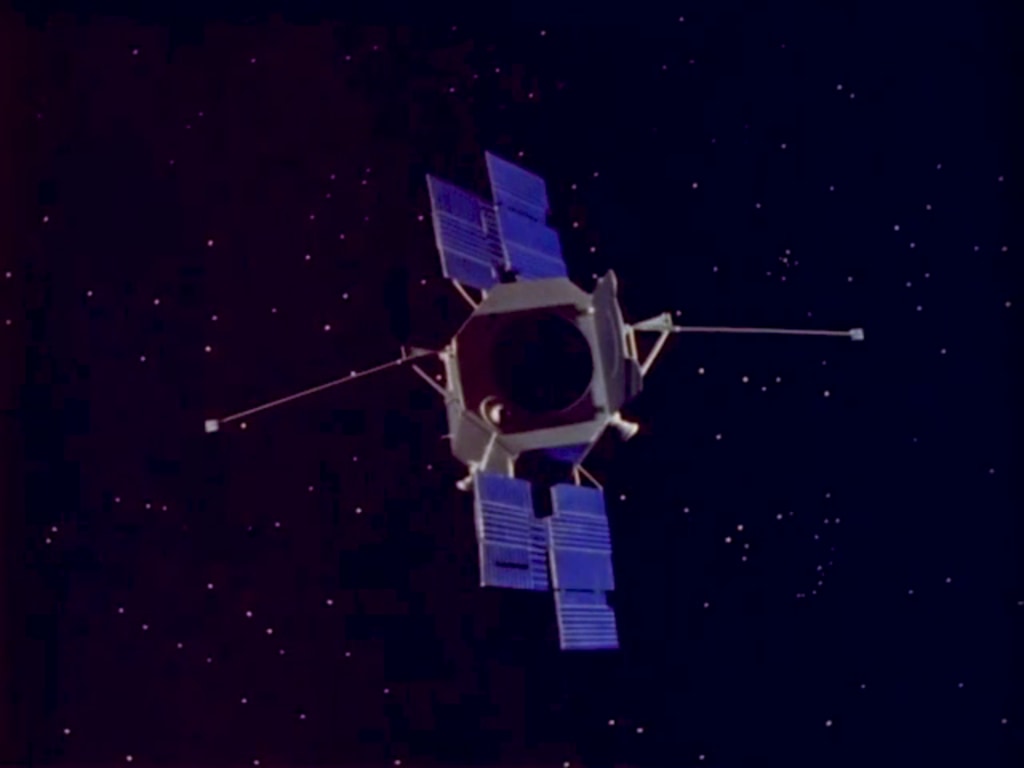50th Anniversary of NASA's Copernicus Mission
Watch: This vintage segment on Copernicus comes from a 1973 edition of “The Science Report,” a long-running film series produced by the U.S. Information Agency.
Credit: National Archives (306-SR-138B)
Watch this video on the NASA Goddard YouTube channel.
Complete transcript available.
NASA’s Copernicus satellite, the heaviest and most complex space telescope of its time, launched into orbit on Aug. 21, 1972.
Initially known as Orbiting Astronomical Observatory C, it was renamed to honor the 500th anniversary of the birth of Nicolaus Copernicus (1473–1543), the Polish astronomer who formulated a model of the solar system with the Sun in the central position instead of Earth.
Fitted with the largest ultraviolet telescope ever orbited at the time as well as four co-aligned X-ray instruments, Copernicus was arguably NASA’s first dedicated multiwavelength astronomy observatory.
The UV telescope produced a treasure trove of information about interstellar gas and the ionized outflows of hot stars. Copernicus measured the UV light of stars to sample the gases between them, finding evidence that most of it comes in the form of molecular hydrogen.
The X-ray experiment discovered several long-period pulsars, including X Persei. Pulsars – typically, spinning neutron stars – swing a beam of radiation in our direction each time they rotate, usually at tens to thousands of times a second. Oddly, the X Persei pulsar takes a leisurely 14 minutes per spin. The mission performed long-term monitoring of other pulsars and bright sources.
Copernicus returned UV and X-ray observations for 8.5 years before its retirement in 1981 – data that appear in more than 650 scientific papers. Its instruments studied some 450 unique objects targeted by more than 160 investigators in the United States and 13 other countries.
B roll of Copernicus pre-launch activities and launch. Technicians in the Hangar AE clean room at Cape Canaveral Air Force Station, Florida, mount solar panels and check out the spacecraft. At 1:13, Copernicus is placed into its payload fairing. At 1:54, the gantry at Launch Complex 36B rolls back. At 2:23, various shots of the Aug. 21, 1972, launch.
Credit: National Archives (255-S-5436, 255-S-5430, and 255-S-5916)

Orbiting Astronomical Observatory C stands in the Hangar AE clean room at the Cape Canaveral Air Force Station, Florida, following the mounting of its stationary solar panels. Once in orbit, the observatory was named Copernicus in honor of Nicolaus Copernicus (1473–1543), the Polish astronomer regarded as the founder of modern astronomy. Credit: National Archives (255-CB-72-H-873)

Technicians in the Hangar AE clean room at Cape Canaveral Air Force Station, Florida, check out Orbiting Astronomical Observatory C following the mounting of its stationary solar panels.
Credit: NASA

Technicians in the Optical Test Facility at NASA's Goddard Space Flight Center in Greenbelt, Maryland, check the 32-inch (82 centimeter) primary mirror of the Princeton Experiment Package, the main instrument on Copernicus, in July 1972. At the time, the mirror was the largest one ever orbited.
Credit NASA

Technicians in the Hanger AE clean room at the Cape Canaveral Air Force Station, Florida, check out Orbiting Astronomical Observatory C in July 1972.
Credit: National Archives (255-CB-72-H-873)

This 1971 illustration shows how our atmosphere absorbs (stippled regions) some wavelengths of light from space while allowing others to pass through it. The primary instrument on Copernicus observed ultraviolet light that cannot be detected from Earth's surface.
Credit: NASA

Illustration of Copernicus in orbit.
Credit: NASA

Illustration of Copernicus in orbit.
Credit: NASA

Illustration of Copernicus in orbit.
Credit: NASA

Atlas Centaur 22, which sent Orbiting Astronomical Observatory C (later named Copernicus) into space, undergoes prelaunch tests at Cape Canaveral Air Force Station, Florida.
Credit: National Archives (255-CB-72-H-1043)

At 6:28 a.m. EDT on Aug. 21, 1972, Copernicus lifted off from Complex 36B at Cape Canaveral Air Force Station, Florida.
Credit: NASA

A July 1971 article from Goddard News celebrated the OAO C development effort as the team prepared for its launch the following year.
Credit: NASA's Goddard Space Flight Center

A January 1981 article from Goddard News describes the end of OAO-C's mission and summarizes its successes.
Credit: NASA's Goddard Space Flight Center

This mid-1960s illustration shows an astronaut servicing a future OAO satellite. Astronauts made orbital repairs to Skylab, NASA's first space station, in 1973 and to the Solar Maximum Mission satellite in 1984. But the vision illustrated here found its ultimate realization with the five successful missions to service and upgrade the Hubble Space Telescope from 1993 to 2009.
Credit: NASA

A sticker design for OAO C.
Credit: NASA's Godard Space Flight Center
For More Information
Credits
Please give credit for this item to:
NASA's Goddard Space Flight Center. However, individual items should be credited as indicated above.
-
Producer
- Sophia Roberts (Advocates in Manpower Management, Inc.)
-
Science writer
- Francis Reddy (University of Maryland College Park)
-
Scientist
- Brad Cenko (NASA/GSFC)
Release date
This page was originally published on Friday, August 19, 2022.
This page was last updated on Wednesday, May 3, 2023 at 11:44 AM EDT.
